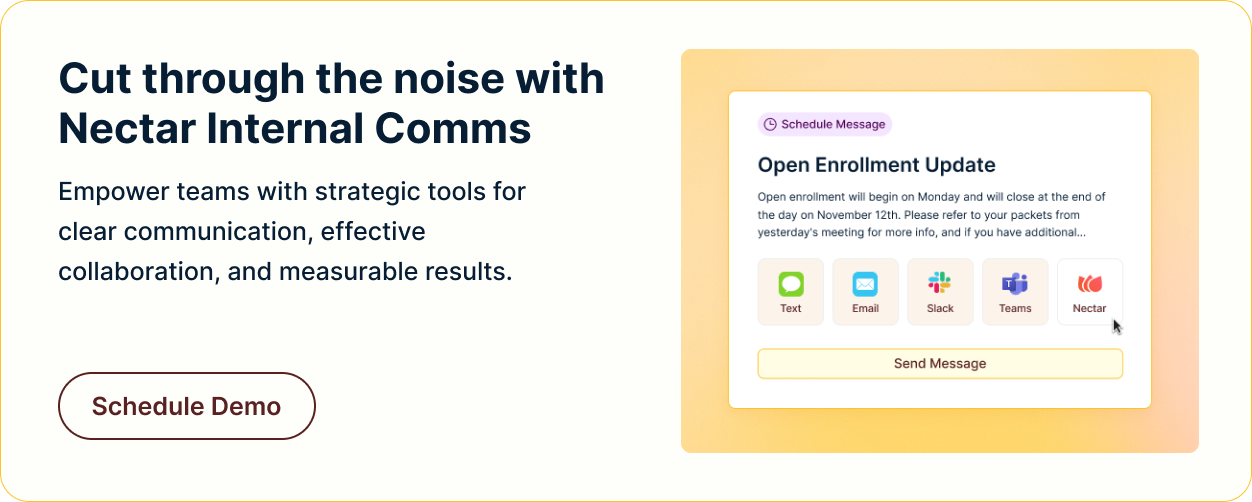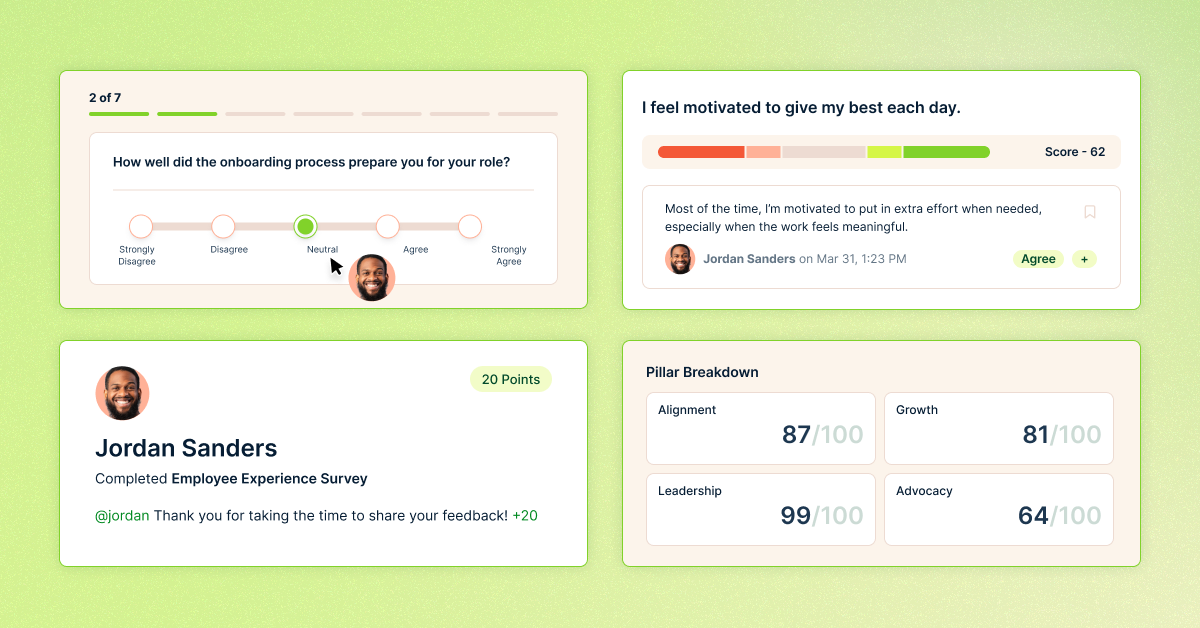Measuring How Internal Communications Influence Employee Morale

Here's the TL;DR
Internal communication directly influences how employees feel about their work—affecting trust, motivation, and morale. Every announcement you make can spark emotions that shape the employee experience. Data from Nectar shows that 91% of employees believe internal communication is the top factor impacting their morale. Organizations with clear, consistent messaging see much higher engagement levels than those with poor communication practices.
Why Internal Communication Matters
Strong internal comms foster psychological safety, clarity, and belonging. When done right, they help employees:
- Feel informed and secure in their roles
- Trust leadership decisions
- Stay emotionally connected to the company mission
Top Metrics to Track Communication Effectiveness
To ensure your messages land well, track both quantitative and qualitative metrics:
- Quantitative: Engagement scores, open/click rates, campaign completion, survey participation
- Qualitative: Feedback themes, perceived clarity and tone, psychological safety, emotional sentiment
Best Practices for Success
- Use real-time tools (e.g., pulse surveys) for continuous insight
- Set KPIs tied to business outcomes like trust and reach
- Act on data with transparent follow-up plans
- Share results across leadership and frontline teams
Every single message you send or announcement you make at work sparks some kind of reaction. Joy, anger, disgust, fear—it’s the full cast of “Inside Out,” and every one of them plays a role in the employee experience.
What you say, how you say it, and when it lands all shape how people feel about work. And that emotional response directly affects their employee morale. The good news is that internal communication doesn't have to be a guessing game. With the right internal communications metrics, you can move beyond gut feeling and use real data to understand and influence how employees engage with your messages.
In this article, we’ll walk you through the most effective strategies for employee morale measurement, how to track your communication efforts, and how to act on the insights you gather.
What Is The Connection Between Internal Communications And Employee Morale?
Employees want to be "in the know" about what's going on in their workplace and how it affects their position, their opportunities, and their pay. Strong communication lets employees feel secure in their roles, understand what's expected of them, and know who to approach with any concerns; it's the foundation all companies need to function effectively. And when communication is missing or dysfunctional, morale and engagement take a nosedive.
When Nectar surveyed 1,000 full-time employees in the US, we found that communication and engagement are inextricably linked. In particular:
- Among employees who rated their organization’s communication as excellent (33.7%), 79.5% also rated employee engagement as high or extremely high.
- In contrast, of those who rated communication as fair or poor (16.6%), only 7.8% rated engagement highly.
- 91% of employees said internal communication has the most significant impact on their morale.
The Psychology Behind Communication Behind Employee Morale
A BMC Psychology study reveals that internal comms shape how employees feel, behave, and connect with their work. Researchers identified three core psychological drivers behind morale-building communication:
- Creating a healthy work environment (psychological safety, inclusion, open dialogue),
- Fostering positive personality development (autonomy, clarity, purpose)
- Encouraging emotional fulfillment during the workday (gratitude, joy, belonging)
When internal messaging reflects these dimensions, employees are more likely to feel motivated and connected to organizational goals—all the good stuff.
8 Key Metrics For Measuring Internal Communication Impact
Your internal comms team is already pumping out the newsletters, and hosting regular Q&A sessions—but how do you know if your messaging really lands with your audience? Consider tracking a handful of carefully chosen metrics. The goal isn’t to collect all the data—just the metrics that align with your company’s goals and audience needs.
Quantitative Metrics
Quantitative metrics give you hard data on your internal communication effectiveness. These numbers track reach, engagement, and behavioral patterns over time to see what's working and where you should adjust your campaigns. Here are four essential quantitative metrics to consider:
1. Employee engagement metrics
Track overall employee engagement metrics using standardized tools like eNPS, pulse surveys, or Gallup Q12. Look for trends that are strong employee morale indicators:
- Participation in surveys and polls
- Meeting attendance
- Event involvement
2. Communication channel effectiveness
How well do specific internal communication tools deliver messages? Focus on core performance indicators like open rates, click-throughs, posts, reactions, and replies to understand what’s getting seen and where the conversation is flowing (or stalling.)
According to Nectar’s research, the top workplace communication tools are:
- Microsoft Teams
- Internal newsletters
But your organization may have a different blend of communication channels. Learn yours to assess reach and quickly identify when key messages fall flat.
3. Survey response rates
Do employees submit feedback surveys before the deadline or send them straight to the recycling bin? When participation is high, this suggests your people trust and are engaged in your communications efforts.
Nectar tip: Track changes in response rates over time to identify communication fatigue or rising engagement.
4. Internal campaign completion rates
If your comms are tied to a specific action, such as enrolling in your benefits program or completing cybersecurity training, track what employees do after reading your message.
Reveal whether employees are following through by tracking:
- % of employees who completed the action
- Time taken from announcement to completion
- Drop-off rates along the way
Qualitative Metrics
If quantitative data tells you what’s happening, qualitative metrics explain why. These insights reveal how employees feel about internal communications—what they trust, what resonates, what confuses them, or what they simply tune out.
Nectar tip: You can collect some of the metrics below using rating scales or other numerical tools (e.g., Likert questions), which technically produce quantitative data. But because these metrics focus on perceptions and experiences, they function as qualitative tools in context, especially when paired with open-ended follow-up questions.
Here are four rich qualitative indicators worth tracking:
5. Employee feedback themes
Forget the yes/no questions because real insight actually lives in your open text boxes or anywhere else employees can let rip with their insights. Whether through survey comments, listening sessions, or skip-level meetings, themes in employee feedback can reveal patterns you'd never see in structured data.
Look for recurring signals around:
- Communication overload (“Too many updates—I don’t know what’s important anymore.”)
- Lack of transparency (“Decisions are made without context.”)
- Leadership tone (“This update felt cold and dismissive.”)
- Emotional energy (“This felt exciting” vs. “This came out of nowhere.”)
6. Perceived clarity and trustworthiness
You might think you’re being clear, but do your employees feel the same? It’s easy for well-intentioned updates to miss the mark if they’re too high-level, overly vague, or simply not what people were hoping to hear.
One common pitfall: companies often fail to spot the gap between what employees need and want to know. Leadership might deliver strategic priorities while employees are still wondering, "How does this affect my workload, my team, or my job security?"
To uncover how your messages are landing, use survey statements like:
- “I understand why leadership makes the decisions they do.”
- “I feel the information I receive is honest and timely.”
- “I know where to go when I need answers.”
These qualitative responses identify whether your communication builds trust or leaves employees confused and disconnected.
7. Psychological safety around communication
Even the most polished internal messaging can fall flat if employees don’t feel safe to speak up and actually respond to it. Psychological safety is the invisible layer beneath every successful communication strategy; it’s what makes people feel confident enough to ask questions or share concerns without fear of backlash.
You can assess this with qualitative prompts like:
- “I feel comfortable giving upward feedback.”
- “Mistakes are treated as learning opportunities.”
- “I can ask questions without fear of judgment.”
If your people feel they need to censor themselves or stay silent altogether, that's a sign your comms aren't fostering trust. On the flip side, when psychological safety is high, employees become more candid, collaborative, and engaged. It's a powerful morale multiplier.
8. Tone and sentiment perception
Tone is everything in your internal communications. Something as simple as weaving in emojis to soften the text or accidentally using capitals that "shout" out loud can drastically impact how people receive your message.
Even when the content is correct, if the tone feels too formal, cold, or cheerful at the wrong moment, it can leave employees with a bad taste in their mouths.
To understand how your tone resonates, ask employees to describe how recent messages made them feel. Were they:
- Motivated?
- Confused?
- Disconnected?
- Empowered?
You can gather sentiment data through pulse checks, quick polls, roundtable discussions, or even emoji sliders built into your comms tools. Most importantly, pair these responses with an open-text follow-up, such as “Why did you feel that way?” to uncover what’s driving the emotional response.
Best Tools And Methods For Measurement
Once you’ve identified the right internal communications metrics, the next challenge is accurately tracking them. Too often, teams rely on a single, static annual survey and call it a day. But capturing a true picture of employee sentiment and message effectiveness requires more flexibility and variety.
Here’s how to capture your communication effectiveness measurements.
Employee Surveys And Feedback Forms
Surveys are a cornerstone of internal communication measurement, but they only work if your employees trust the process and see action afterward.
Annual engagement surveys can give you a helpful snapshot of morale, trust, and communication clarity across the organization. You can also run more targeted surveys after major change.
To get the most out of your surveys:
- Ask both closed-ended and open-ended questions to balance quantitative and qualitative data
- Keep them short to reduce fatigue
- Clearly communicate what will happen next based on the results
Pulse Checks And Real-Time Feedback
Short, regular check-ins, for example, weekly or biweekly, can give you a more accurate sense of how people are feeling in the moment. Some internal communications tools even allow you to embed one-click sentiment questions directly into email or Teams chats.
These pulse checks are especially powerful during:
- Organizational changes
- Leadership transitions
- Cultural initiatives or new policy rollouts
From here, you can adjust your communication tone and content as things unfold, not months after the fact. These checks also let you monitor employee engagement metrics and declining employee morale indicators more frequently, allowing you to jump on them before they become deeper issues.
CEO Anu Mandapati of Qultured highlights how real-time feedback loops can enhance communication effectiveness:
“Rather than waiting for an annual engagement survey, we embed feedback into the flow of work. After a leadership offsite, we do 15-minute debriefs. After change rollouts, we check in with one key question: “What’s one thing that’s working well and one thing we should rethink?”
These smaller, more frequent pulses lower the stakes and create real-time loops for adjustment. They also surface insights that would never appear in a formal, annual survey.”
Internal Communications Analytics
Analytics isn’t something you have to track manually with a notepad and pen, or even a spreadsheet. Modern internal communications platforms are equipped with built-in analytics functionality to track delivery, engagement, and reach. The data reveals how your messaging is performing from a technical standpoint. Use it to:
- See which messages are read or ignored
- Spot channel fatigue early
- Identify gaps in message visibility across departments or locations
How To Implement Your Internal Communications Measurement Strategy
Data is just a bunch of numbers unless there’s a clear internal communications strategy behind them. Use the following steps to bring the numbers to life.
Set Your Baseline Measurements
How do you know whether your metrics fall into the concerning, average, or high-performing range? Start by establishing a baseline, from which you'll track progress based on what normal looks like for your team.
Take baselines of your:
- Current engagement scores
- Typical email open/click rates
- Survey response rates
- Most/least used communication channels
- Qualitative sentiment (via recent open-text feedback or roundtables)
Nectar tip: Take a snapshot of your metrics across multiple formats (email, Slack, surveys, meetings) to get a fuller picture of your internal communications ecosystem and surface early employee morale indicators that may otherwise go unnoticed.
Create Measurement Schedules
The next step is to schedule your communication effectiveness measurement in line with your business needs. But what’s the right cadence?
You don’t need to track everything every week, but you do need a plan that balances consistency with practicality. Here’s a simple starting framework for your internal communications strategy:
- Weekly = Pulse check questions, employee engagement analytics (e.g., Slack/Teams engagement)
- Monthly = Email open rates, campaign completion stats, feedback volume
- Quarterly = Engagement scores, survey results, feedback theme analysis
- Annually = Deep-dive employee engagement surveys, channel audits, strategy reviews
Nectar tip: Align your measurement cadence with key business milestones; for example, if you announce major changes to your compensation philosophy, or following news of an acquisition.
Develop Your Key Performance Indicators
Once you've set your schedule, it's time to decide what success looks like. This is where your key performance indicators (KPIs) come in. KPIs turn vague goals like "improve morale" or "reduce burnout" into trackable outcomes you can monitor and act on.
Start by linking your internal communication goals to tangible, measurable indicators. For example:
- Goal: Improve trust in leadership communications
- KPI: 20% increase in “I trust leadership is transparent” survey responses
- Goal: Increase message reach across the company
- KPI: 80%+ average open rate on all-staff newsletters
- Goal: Boost feedback participation
- KPI: 10% increase in monthly pulse check completion
Nectar tip: Keep your KPIs realistic, time-bound, and aligned with your broader employee engagement or business strategy.
Collect Your Data
Choose one or more collection tools according to the metrics you’re tracking and the solutions you use in your regular workflows. Some options:
- Surveys and polls: Ideal for capturing employee engagement scores, sentiment, preferences, and feedback themes
- Built-in analytics: Most comms platforms offer engagement data like open rates, reactions, and reach
- Pulse tools: Dedicated software allows for seamless, regular check-ins
- Focus groups and 1:1 interviews: Best for uncovering deeper insights and testing messaging tone before larger rollouts
- Manual audits: Periodic review of campaign performance, platform usage, or survey participation can reveal long-term trends
Analyze And Act On Your Results
Too many companies pour efforts into asking the perfect questions, distributing surveys, and sending reminders for employees to engage with their comms. But it all becomes meaningless when they don’t commit to the follow-up: assessing and acting on the results.
Imagine you receive 500 employee satisfaction surveys, and 83% of people tell you they don’t understand how your mentoring program works. They’ve seen it mentioned occasionally in your company newsletter, and heard it referenced at an all-hands, but there’s no clarity on who’s eligible, how to join, or what the benefits are. If that feedback is quietly filed away or ignored, what’s the point of collecting the data?
To improve your internal communications ROI, follow the steps below to turn your data into action and build lasting trust through communication.
Follow Data Interpretation Best Practices
Instead of jumping to conclusions about what the numbers mean, take the time to look for themes, emotional tone, and alignment between what employees say and what they may actually be experiencing.
Some best practices:
- Compare qualitative and quantitative findings—does the sentiment match the numbers?
- Look for patterns over time, not just spikes in a single survey
- Segment by department, tenure, or location to understand experience gaps
Create Action Plans
Once you understand the insights, you need to show employees that their voices lead to real, visible change. Your action plan should include:
- What you heard: A clear summary of feedback themes
- What you’re doing: Tangible actions, not vague intentions
- Who’s responsible: Ownership and timelines
- How you’ll follow up: Keep employees informed of progress
Remember: Even when your action plan includes wins or improvements, some employees may still focus on what wasn’t addressed. Be intentional about reinforcing progress and recognizing what's working, not just patching what’s broken.
Report To Stakeholders
Internal communication intersects with every part of the business, so one of your best practices should be to share your measurement insights widely with key stakeholders in your organization. Communicate your findings to:
- Executive leadership to inform cultural strategy, morale initiatives, and change communication
- HR and People teams to align with employee engagement, onboarding, and retention goals
- Department heads to tailor messaging strategies across functions and identify group-specific gaps
- Managers to respond to local sentiment shifts on the ground
Tailor your reports to the audience. Typically, executives require high-level summaries tied to business outcomes, while managers need specific guidance on improving message clarity or feedback loops within their departments.
Use clear visuals, concise summaries, and real examples to show how your internal communication strategy supports the employee experience at scale.
Make A Continuous Improvement Strategy
To truly influence morale and engagement, organizations must build a culture where feedback is continuously gathered and improved upon.
That doesn’t mean bugging your employees every day with a new set of survey questions to answer. But it does mean establishing employee feedback systems that create space for action, even in small ways.
As Anu Mandapati, CEO of Qultured, shared:
“One leader I worked with turned around a stagnant team by doing monthly ‘pulse and plan’ sessions—15 minutes of gathering feedback, followed by a shared commitment to one small improvement. In 90 days, team sentiment shifted from disengaged to energized, and output improved without increasing hours.”
Follow this example and build in regular checkpoints to:
- Reassess your KPIs
- Review communication trends
- Re-align with employee needs
- Share progress with your workforce
When employees consistently see that their input shapes how the company communicates, it creates a culture of responsiveness and respect—which fuels long-term morale.
Achieve Internal Communication Excellence With Nectar
Effective internal communication is pivotal to employee morale and overall organizational success. Nectar’s internal communication platform supports HR teams and company leaders in achieving both.
Our dedicated suite allows you to:
- Cut through the noise with strategic tools for clear communication, effective collaboration, and measurable results
- Craft jaw-dropping announcements using our drag-and-drop message builder
- Meet your employees wherever they are, for example, in email, text, Teams, or Nectar itself
- Manage your internal communications strategy with tools to segment users and schedule broadcasts so it never feels like overkill
- Capture actionable data in real time, such as top-clicked content, open rates, and more.
Ready to boost employee morale with effective internal messaging? Download our internal communications measurement template, and schedule a free Nectar demo today to kickstart the process. You can also register for our newsletter to stay updated on all things communication, culture, and employee engagement.















